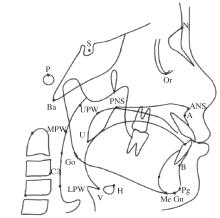Journal of Jilin University(Medicine Edition) ›› 2021, Vol. 47 ›› Issue (5): 1273-1280.doi: 10.13481/j.1671-587X.20210527
• Research in clinical medicine • Previous Articles Next Articles
Analysis on main factors affecting sagittal diameter of upper airway in children with skeletal class Ⅱ malocclusion during growth and development period
Chenmeng LU,Yi ZHANG,Maoyun YIN,Mamat MIHRIZAT,Xinyu LIU,Min HU( )
)
- Department of Orthodontics,Stomatology Hospital,Jilin University,Changchun 130021,China
CLC Number:
- R783.5


 畸形患病率的调查[J]. 中华口腔医学杂志, 2002, 37(5): 371-373
畸形患病率的调查[J]. 中华口腔医学杂志, 2002, 37(5): 371-373 青少年上下颌骨垂直向及纵向变化的研究[J]. 临床口腔医学杂志, 2010, 26(6): 326-329.
青少年上下颌骨垂直向及纵向变化的研究[J]. 临床口腔医学杂志, 2010, 26(6): 326-329.


